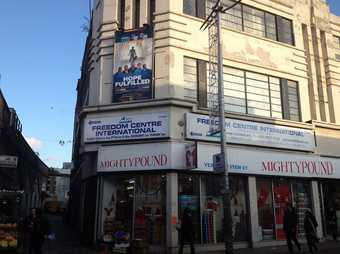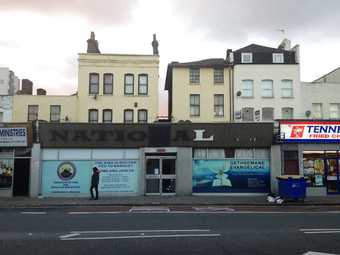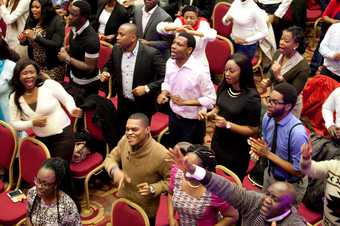
Recce shot of the Freedom Centre International church on Rye Lane in Peckham, Southwark© Chloe Dewe Mathews
I was brought up going to church on Sunday. The smell of incense, uncomfortable pews and the sad sight of a fifteen-person congregation grinding through hymns without an organ are my abiding memories. I was therefore thrilled to arrive at Liberty House Church, my first shoot in Peckham (five minutes walk from my house) to find a full audio visual extravaganza of coloured lights, a sound desk with eight piece band, projection screens and two hundred worshippers filling the former ironmongery.
Although I’ve been a South Londoner all my life, much of my recent work has been done overseas, most notably in Azerbaijan, Kazakhstan and southern Russia. When the team at Tate Modern commissioned me earlier this year to make a new body of work responding to the area of South London in which we both operate, I was delighted.
Beginning in November 2013, my brief was to reference Tate Modern’s new extension and observe changes that are taking place elsewhere in the area. The modification of ex-industrial buildings into art spaces is now commonplace; even at the end of my road artist Raqib Shaw has converted an old sausage factory into his studio, and Anish Kapoor’s headquarters occupy a former shutter-making workshop only five minutes away. Of course, Tate Modern itself is a converted power station; however in recent years, it’s not the transition of space from industry to culture that has caught my intention.

Recce shot outside the Mountain of Fire and Miracles Ministries on Camberwell Road, Southwark© Chloe Dewe Mathews
There are over 240 new black majority churches in Southwark, more than double all other types of church in the area. Recent research by Roehampton University suggests that this represents the greatest concentration of African Christianity in the world, outside of Africa. The churches of the borough are set up in old factories, warehouses and bingo halls. Ex-industrial buildings are chosen for practical reasons: they are cheap and able to accommodate large numbers of people, who can be as loud as they like without upsetting neighbours.
I have noticed the number of these churches grow rapidly in recent years, and become fascinated by them. As well as the role they play in the energetic street life of the borough, I am interested in the very distinctive style of worship they practice. Over the next few months, in photographs to be published this spring, I will be observing and recording the performative and often expressive way in which the services are held, and in doing so, will try to discover more about the ideology of these churches. Do you live in Southwark and attend an African church? What kind of impact do you think they have on the area? I’d be interested to hear what you think.
Tate Modern and Youis a publication regularly produced in partnership with a neighbourhood or section of the local community, in collaboration with an artist. It aims to make stronger links with different communities across the London boroughs of Southwark and Lambeth

